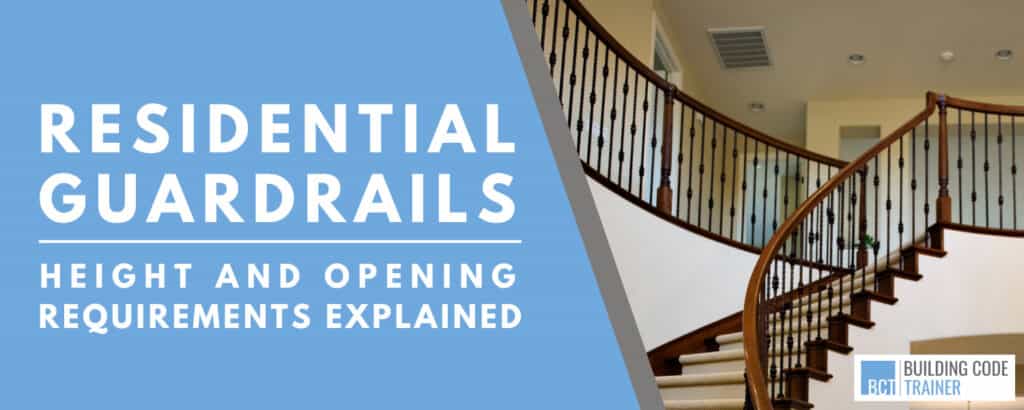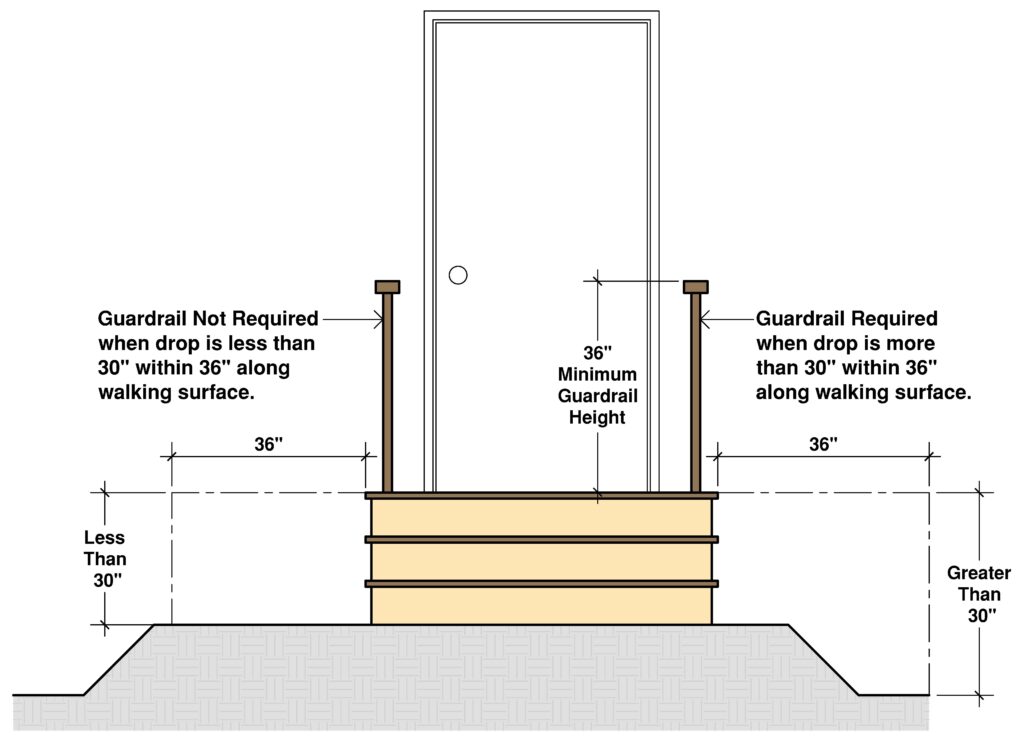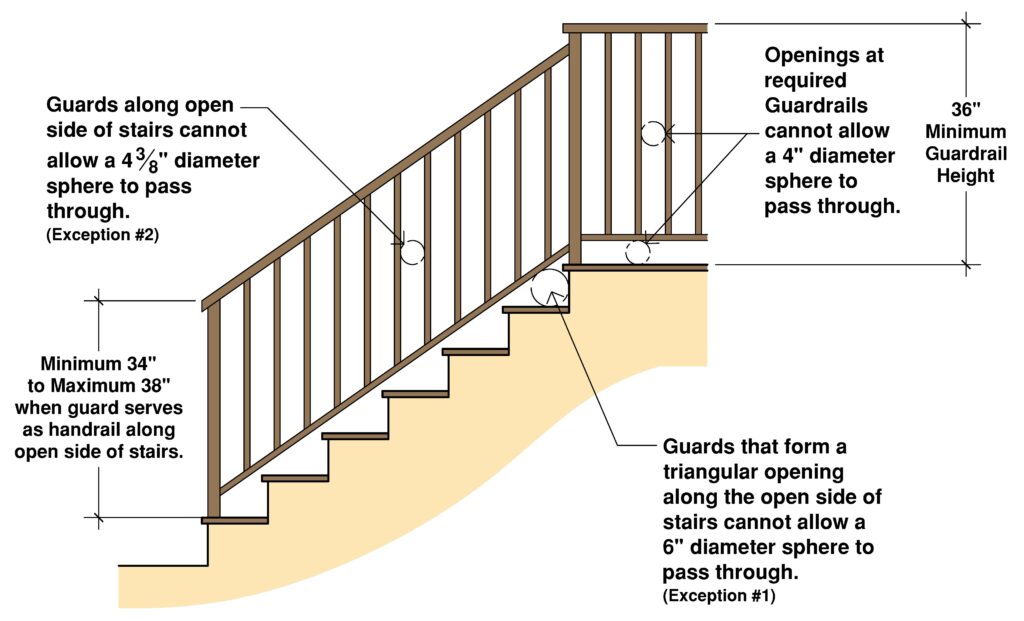Author : Building Code Trainer

Guardrails are installed to protect occupants from falling from various types of walking surfaces. The International Residential Code (IRC) establishes the requirements for guardrails to ensure a standard of safety for the user.
These guardrail requirements are found in Section R312 of the 2021 International Residential Code (IRC). This section explains when guardrails are required, the minimum height, and opening limitations to provide a minimum level of safety.
Fun Tip: To learn the difference between the International Residential Code (IRC) and the International Building Code (IBC), be sure to check out this POST.
Before we get into the details, let me explain some terminology. Section R312 is Titled “Guards and Window Fall Protection”. In this post we will just discuss the topic of Residential Guards. As for Window Fall Protection Requirements, be sure to check out This Post.
Now as for Guards, per the definition found in Chapter 2 of the IRC, a Guard is defined as the following:
“A building component or a system of building components located near the open sides of elevated walking surfaces that minimizes the possibility of a fall from the walking surface to the lower level.”
So a guard can be a building component such as a small wall that meets the minimum height requirement for a guard. Since guardrails are commonly used to serve as a guard, we want to see how this section applies to guardrails so that they can comply as a “Guard” as defined per Section R312.
Now lets take a look at these sections as we explain the requirements.
Where are Guardrails required? (R312.1.1)
The open side of any walking surface, which include floors, stairs, ramps, and landings, must be provided with a guardrail when the floor surface is located more than 30 inches (measured vertically) to the adjacent floor or grade at any point within 36 inches (measured horizontally) from the edge at the open side of the walking surface.
To better understand this visually, lets take a look at the graphic below:

So whether there is a slope or a sudden drop, a guardrail shall be provided when the drop is more than 30 inches within 36 inches from the edge of the open side.
Minimum Required Guardrail Height (R312.1.2)
When a guardrail is required per the above explanation, it must meet a minimum height requirement of no less than 36 inches for it to serve the purpose of minimizing a fall. The height is measured vertically above the walking surface or the line that connects the nosing of a set of stairs.
However there are 2 exceptions to this.
Exception 1
Since guards must also be provided at stairs that have a drop of more than 30 inches, they are allowed to be at a height of no less than 34 inches when the guard does not act as a handrail. The height is measured vertically from the line connecting the nosing.
Exception 2
As for guards along a set of stairs that serve as a handrail as well, they are allowed to be at a height of no less than 34 inches but no more than 38 inches. The height is measured vertically from the line connecting the nosing. Guardrails do not have a height limitation, except for when they serve as a handrail as well as a guardrail.
Important Note: One very Important thing to note here is to understand that these requirements are per the International Residential Code (IRC) however other state or local codes can differ which is why it is always best to get in contact with your local jurisdiction to understand which code is adopted.
For example, in California the guardrail height requirement per the California Residential Code (CRC) is to be no less than 42 inches. With that said let us continue with the IRC provisions.
Guardrail Opening Limitations – Baluster Spacing (R312.1.3)
Baluster Spacing for Guardrails
When openings occur in a guardrail they must be spaced in such a way that the opening will not allow a 4 inch diameter sphere to pass through. So basically the spacing should be less than 4 inches.
However there are 2 exceptions to this.
Exception 1
Exception 1 allows the triangular opening formed by the riser, tread and bottom rail of the guard to be larger, but at no point shall it allow a 6 inch diameter sphere to pass through.
Exception 2
Exception 2 allows the guard located along the open side of a stair run to be just slightly larger however at no point shall it allow a 4-3/8 inch diameter sphere to pass through.
To better understand this visually, lets take a look at the graphic below:

.
Summary of Guardrail Requirements
1. A Guardrail is required along the open side of any walking surface, which include floors, stairs, ramps, and landings, provided the drop is more than 30 inches within 36 inches from the edge.
2. The Guardrail height shall not be less than 36 inches above the walking surface or line connecting the nosings.
- Exception 1: Guardrails located at the open side of a stair run shall not be less than 34 inches in height.
- Exception 2: Guardrails serving as handrails on the open side of a stair run shall not be less than 34 inches and not more than 38 inches in height.
3. Any opening in a Guardrail shall not allow a 4 inch diameter sphere to pass through.
- Exception 1: Triangular openings formed by the riser, tread and bottom rail of the guard shall not allow a 6 inch diameter sphere to pass through.
- Exception 2: Openings in a Guardrail located along the open side of a stair run shall not allow a 4-3/8 inch diameter sphere to pass through.
For more information, see Section R312 of the 2021 International Residential Code for a more in-depth look at guardrail requirements.
Related Articles to Read:
- Is My Spiral Staircase Code Compliant?
- Are Ship Ladders Code Compliant?
- Are Alternating Tread Devices Code Compliant?
About the Author

Building Code Trainer
AuthorThis site is run and maintained by a Certified Building Official, Plans Examiner, and Inspector. With a Bachelors of Science Degree in Construction Engineering along with holding multiple ICC certifications, the Author of this site has over 15 years of experience within the construction industry.
